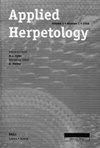Optimising the design of artificial refuges for the Australian skink, Egernia stokesii
引用次数: 18
Abstract
Western subspecies of the Australian skink Egernia stokesii are considered endangered and translocation to unoccupied areas of suitable habitat has been proposed as a conservation strategy. We investigated the internal structure of artificial refuges that might induce translocated lizards to remain at the site of release. In a laboratory environment, individual lizards were offered choices of alternative structures as refuges. They preferred deeper and narrower refuge structures, with a single entrance rather than two entrances. They showed a slight tendency to avoid PVC structures when plywood or brick paving alternatives were available. Soft sand or hard brick substrate were equally accepted. The results suggest that the use of brick pavers may be a practical management strategy to provide extra refuges for the lizards, but further trials are needed with a greater range of temperatures that are representative of field conditions.优化澳大利亚石龙子、埃及石龙子的人工避难所设计
澳大利亚石龙子Egernia stokesii的西部亚种被认为是濒危物种,并被提议将其转移到合适栖息地的无人居住地区作为一种保护策略。我们研究了人工避难所的内部结构,它可能诱导迁移的蜥蜴留在释放地点。在实验室环境中,蜥蜴个体可以选择不同的结构作为避难所。他们更喜欢更深更窄的避难结构,只有一个入口而不是两个入口。当有胶合板或砖铺装替代品时,他们表现出轻微的避免PVC结构的倾向。软砂或硬砖基材均可接受。结果表明,使用砖铺路机可能是一种实用的管理策略,可以为蜥蜴提供额外的避难所,但需要进一步的试验,在更大的温度范围内代表野外条件。
本文章由计算机程序翻译,如有差异,请以英文原文为准。
求助全文
约1分钟内获得全文
求助全文

 求助内容:
求助内容: 应助结果提醒方式:
应助结果提醒方式:


